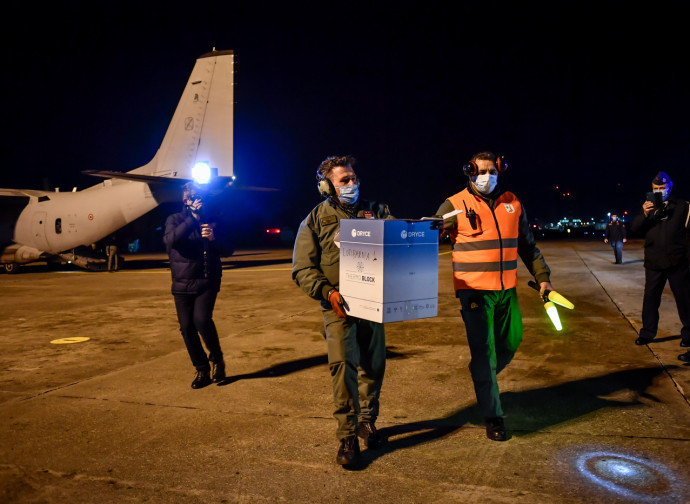The ‘holy’ vaccine, a leap into the void that won’t save us
27 December 2020 will go down in history as V-Day, Vaccination Day: the day when the vaccine counter-offensive was unleashed against Covid across Europe. Announced in emphatic and rhetorical terms for a colossal propaganda operation, the antidote became ‘light and hope’. But none of the Phase III studies have been structured to prove the effectiveness of the vaccines in reducing serious outcomes such as hospitalisations, intensive care need, or deaths. Their isn’t sufficient evidence to assess their benefits and damages.

27 December 2020 will go down in history as V-Day, or Vaccination Day: the day when the vaccine counteroffensive was unleashed against Covid across Europe. A sort of D-Day. It was announced in such emphatic and rhetorical terms by the German President of the European Commission: “Vaccination Day is a moving moment of unity. Vaccination is the lasting way out of the pandemic”, Von Der Leyen wrote in a note she posted on Twitter.
Technically, all the doses of the Pfizer/Biontech vaccine have already been delivered to the EU countries, and the vaccination campaign can begin the very next day, simultaneously in all the member states to give a sign of cohesion and underline the turning point, as the head of the European executive pointed out, stressing that from today we are starting to turn the page. “Vaccination will gradually bring us back to normality,” she concluded, reminding us to continue to respect hygiene and safety standards until the goal of the vaccination campaign is achieved. V-Day is therefore first and foremost an event of great symbolic value, serving a colossal propaganda operation. We are well aware that propaganda, the communication strategy, is one of the cornerstones of the Great Reset.
V-Day is not only the start of the vaccination procedures, but above all of a media campaign whose aim is to remove all doubt about Covid vaccines, to convince public opinion of their efficacy, safety, and even the moral and civil duty to have them. V-Day marks the conclusion of a long, widespread effort made by the media and social networks, on behalf of individual governments and now by the EU itself, to give a precise and unambiguous interpretation of the epidemic, which can be summarised as follows:
We are faced with a micro-organism of unprecedented lethality. “There is no cure for the disease caused by this micro-organism. Only a vaccine can save us”.
For months the population has been indoctrinated with these mantras, with a force and determination that drowned out the free voices of scientists and health workers who were able to demonstrate that this was not the case: that the lethality of the virus was not what was being used to terrorise people, and that the disease was curable with a whole range of drugs, all of which were invariably denied. So we finally came to the third point, the final solution.
Soon the European regulatory body will give its approval to vaccines from other pharmaceutical companies. All have passed the test. An incredible success, unique in the hundred-year history of vaccination. They all work very well, and are safe.
The history of Medicine shows many examples of serious adverse events from vaccines put on the market during periods of enormous pressure and expectations. There were contaminated polio vaccines in 1955, cases of Guillain-Barré syndrome in flu vaccine recipients in 1976, and narcolepsy linked to a brand of flu vaccine in 2009.
The efficacy and safety of vaccines placed on the market will be the refrain repeated to convince European citizens to get vaccinated. Yet serious doubts persist about both of these fundamental criteria. In a recent issue of the influential British Medical Journal (BMJ 2020 371) entitled “Will Covid-19 vaccines save lives? Current trials aren’t designed to tell us” reveals that none of the Phase III studies are structured to prove the efficacy of vaccines in reducing serious outcomes such as hospitalisations, intensive care use or deaths. Nor are vaccines being studied to determine whether they can interrupt virus transmission.
“Detecting serious rare adverse events will require the study of tens of thousands of patients, but this requirement will not be met by the early adoption of a product that has not completed its full trial evaluation,” said Harvard Drug Policy researchers Jerry Avorn and Aaron Kesselheim.
Covid-19 vaccine studies are currently designed to rank final efficacy results once 150-160 study participants develop symptomatic covid-19, and most studies have specified at least one interim analysis that allows studies to end with even less accumulated data. We therefore do not have enough evidence to assess the benefits and damages of vaccines. Much more time and studies are still needed. But the vaccination machine is now running at full speed. The Covid vaccine, on the other hand, is no longer a medication. It is much more than that: it is ‘light and hope’, and with this aura of questionable pseudo-sacredness, it is on its way.
V-Day, instead of being a Vaccination Day, risks being a Vacuum Day, the day of the leap into the void.




